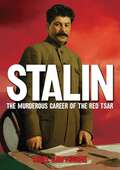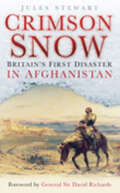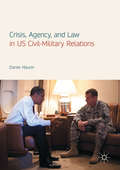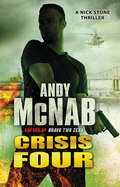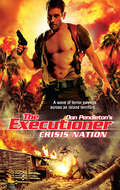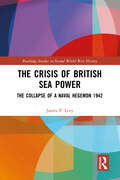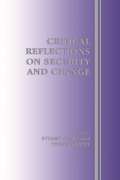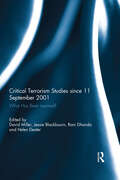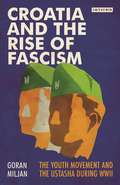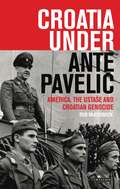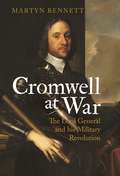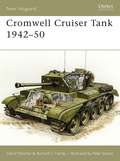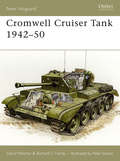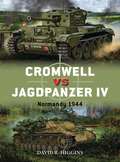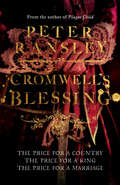- Table View
- List View
The Crimes of Stalin: The Murderous Career of the Red Tsar
by Nigel Cawthorne'Death is the solution to all problems. No man - no problem.'-Joseph StalinWorshipped by the Russians as a great leader, Stalin was one of modern history's greatest tyrants, rivalling Hitler, Mao Zedong and Pol Pot. But he probably had more blood on his hands than any of them.Born Josef Dzhugashvili in Gori, Georgia in 1879, Stalin studied to be a priest while secretly reading the works of Karl Marx. Politics soon became his religion and, under his ruthless rule, up to 60 million people perished.Peasants who resisted Stalin's policy of collectivisation were denounced as Kulaks, arrested and shot, exiled or worked to death in his ever-expanding network of concentration camps, the Gulag. Nobody was safe, not even his friends, his family or his political allies. This is the story of a man who never let up for a second in his pursuit of absolute power.
The Crimson Portrait: A Novel
by Jody ShieldsSet in England during World War I, this haunting love story by the author of the bestselling The Fig Eater makes unforgettably real the ravages of love and war.
Crimson Snow: Britain's First Disaster in Afghanistan (Sutton Ser.)
by Jules StewartIn the mid-nineteenth century, the British and Russian Empires played the ‘Great Game,’ a rivalry for supremacy in Central Asia. To secure a ‘buffer zone’ in Afghanistan, between India and Russian territory, Britain launched the First Anglo-Afghan War in 1838. Initial success, including the imposition of a puppet regime supported by too few troops (a situation that has great resonance today), was followed by complete disaster in 1842, with 4,500 soldiers and 12,000 civilian camp followers killed by rebellious Afghans. Only one Briton is known to have escaped the massacre. This compelling story of imperial misadventure is told by Jules Stewart, a former Reuters journalist with considerable experience in the region and a specialist in North-West Frontier history, and has a foreword from General Sir David Richards, Chief of the General Staff and a former NATO commander in Afghanistan. It provides important parallels with our current commitments in this graveyard of ambitions, and illustrates how little has been learnt from the past.
Crisis, Agency, and Law in US Civil-Military Relations
by Daniel MaurerThis book develops a responsible and practical method for evaluating the success, failure, or “crisis” of American civil-military relations among its political and uniformed elite. The author’s premise is that currently there is no objectively fair way for the public at large or the strategic-level elites to assess whether the critical and often obscured relationships between Generals, Admirals, and Statesmen function as they ought to under the US constitutional system. By treating these relationships—in form and practice—as part of a wider principal (civilian)-agency (military) dynamic, the book tracks the “duties”—care, competence, diligence, confidentiality, scope of responsibility—and perceived shortcomings in the interactions between US civilian political authorities and their military advisors in both peacetime and in war.
Crisis, Agency, and Law in US Civil-Military Relations
by Daniel MaurerThis book develops a responsible and practical method for evaluating the success, failure, or “crisis” of American civil-military relations among its political and uniformed elite. The author’s premise is that currently there is no objectively fair way for the public at large or the strategic-level elites to assess whether the critical and often obscured relationships between Generals, Admirals, and Statesmen function as they ought to under the US constitutional system. By treating these relationships—in form and practice—as part of a wider principal (civilian)-agency (military) dynamic, the book tracks the “duties”—care, competence, diligence, confidentiality, scope of responsibility—and perceived shortcomings in the interactions between US civilian political authorities and their military advisors in both peacetime and in war.
Crisis and Resilience in the Bristol-West India Sugar Trade, 1783-1802 (Eighteenth-Century Worlds #13)
by Peter BucklesHow did merchants deal with crises? From warfare to financial upheaval, from political machinations to the abolition of the slave trade, merchants and their networks in the eighteenth century faced a range of challenges. But they also demonstrated remarkable resilience. Providing new levels of detail on Britain’s sugar trade, this authoritative account explores how Bristol’s sugar merchants embodied cogs in the plantation machine, using their position of influence in Britain to maintain the production of sugar and violent systems of enslavement. It demonstrates how, as shipowners, these merchants protected their shipping, led the organisation of convoys, and took advantage of cheapening insurance. It reveals the inner workings of the sugar market and the strategies merchants used to remain profitable, showing how merchants navigated the transitions between peace and war. Finally, it uncovers their methods for managing credit and safeguarding their investments. Throughout, the nature of commerce in the eighteenth century is analysed in detail, from business networks to bills of exchange. Demonstrating meticulous, interdisciplinary research and thorough analysis of merchant business records, this book speaks broadly to the nature and experience of crisis in the eighteenth century and what this meant for the burgeoning systems of capitalism.
Crisis Four: (Nick Stone Thriller 2) (Nick Stone #2)
by Andy McNabThe bestselling Nick Stone thriller - a heart-stopping novel of violence, betrayal and high-octane suspense.Ex-SAS trooper Nick Stone is extremely highly trained. Clever, ruthless and very effective, it is no surprise that he is hired by British Intelligence. On deniable operations - one of the most dangerous lines of work. Sarah Greenwood is beautiful, intelligent and cunning - and the only woman Stone has ever truly opened up to. But now he has been ordered to hunt her down.Hotly pursued through the American wilderness, Stone finds himself at the centre of a deadly game of cat and mouse. He must get to the heart of a terrifying conspiracy theory to which only Sarah holds the key. But will he manage to before the tension reaches boiling point?'A rollercoaster ride' Guardian
Crisis Nation
by Don PendletonWhen American military personnel are found beheaded in the swamps of Puerto Rico, Mack Bolan boards a plane and lands in a political revolution. As the streets of San Juan turn bloody, he suspects someone outside the country is running the show and the gangs behind the military slaughter are simple pawns in a much more complex game.
The Crisis of British Sea Power: The Collapse of a Naval Hegemon 1942 (Routledge Studies in Second World War History)
by James LevyThis work is a close examination of the conditions surrounding and precipitating the last gasp of British naval hegemony and events that led to its demise. Great Britain undertook a massive naval building program in the late-1930s in order to deter aggression and secure dominance at sea against her nascent enemies, Nazi Germany and Fascist Italy. But the failure of the policy of Appeasement to deter war or delay it into the early 1940s left the building program only partially complete, and the exigencies of war led to the cancellation of the critical but costly and time-consuming “Lion” class battleships, and the slow delivery of the “1940 battlecruiser” (HMS Vanguard) and two vital fleet carriers. Adding to these issues, the fall of France spurred the USA to initiate her own, even larger, naval building program, and together with the entry of the powerful and capable Imperial Japanese Navy completely overwhelmed Britain’s position as the world’s premier naval power. This book will be of value to those interested in the history of the Second World War, British strategy, and the British navy.
The Crisis of British Sea Power: The Collapse of a Naval Hegemon 1942 (Routledge Studies in Second World War History)
by James LevyThis work is a close examination of the conditions surrounding and precipitating the last gasp of British naval hegemony and events that led to its demise. Great Britain undertook a massive naval building program in the late-1930s in order to deter aggression and secure dominance at sea against her nascent enemies, Nazi Germany and Fascist Italy. But the failure of the policy of Appeasement to deter war or delay it into the early 1940s left the building program only partially complete, and the exigencies of war led to the cancellation of the critical but costly and time-consuming “Lion” class battleships, and the slow delivery of the “1940 battlecruiser” (HMS Vanguard) and two vital fleet carriers. Adding to these issues, the fall of France spurred the USA to initiate her own, even larger, naval building program, and together with the entry of the powerful and capable Imperial Japanese Navy completely overwhelmed Britain’s position as the world’s premier naval power. This book will be of value to those interested in the history of the Second World War, British strategy, and the British navy.
Crisis, Reinvention and Resilience in Museums: Defence and Revolution at the Imperial War Museum, 1933-1950
by Philip W. DeansThis book explores museum crises. Through an investigation into the experience of the Imperial War Museum during the Second World War era, 1933-1950, it considers how crises disrupt museums and the contrasting defensive and revolutionary strategies which museums must adopt when mitigating crises. It is situated in a small but emergent literature concerning museums and crisis. Existing works mainly comprise contemporary studies on difficult museum experiences, predominantly financial difficulty, wherein the term crisis has been applied to describe an institution’s general state of malaise. This book, by contrast, presents an innovative and groundbreaking historical case study on a single museum facing wholesale physical and ideological collapse, deploying original crisis concepts to analyse different critical situations and the pathology underlying them.
Critical Reflections on Security and Change
by Stuart Croft Terry TerriffThe contributors reflect critically on security studies since the 1980s. They conclude that analysts and policy-makers have not been able to respond well to the changes that have occurred and that they must revise their approach if they are to meet the challenges of the future.
Critical Reflections on Security and Change
by Stuart Croft Terriff TerryThe contributors reflect critically on security studies since the 1980s. They conclude that analysts and policy-makers have not been able to respond well to the changes that have occurred and that they must revise their approach if they are to meet the challenges of the future.
Critical Terrorism Studies since 11 September 2001: What Has Been Learned?
by David Miller Jessie Blackbourn Helen Dexter Rani DhandaAcademic studies of ‘terrorism’ grew exponentially in number after the September 11 attacks. The problem was that much of this work of ‘orthodox’ terrorism studies was biased, often shoddily researched and was too closely identified with the power centres of Western states. Its denizens were often former and sometimes current officials or officers in the military, intelligence services or the security industry or were funded by them.In response the project of Critical Terrorism Studies was intended to give a more rounded account of political violence in the world. It focuses on neglected issues like state terrorism, Western counterinsurgency, propaganda and misinformation.More than a decade since the founding of the critical project, this book asks what has been learned. It showcases leading examples of critical terrorism studies and presents an agenda for the expansion of an evidence-based approach to political violence and terrorism. With chapters by leading authorities such as Joseba Zulaika, Michael Stohl, Mary Hickman and Richard Jackson, the book evaluates how far the critical project has come and where it is going next.This book was published as a special issue of Critical Studies on Terrorism.
Critical Terrorism Studies since 11 September 2001: What Has Been Learned?
by David Miller Jessie Blackbourn Rani Dhanda Helen DexterAcademic studies of ‘terrorism’ grew exponentially in number after the September 11 attacks. The problem was that much of this work of ‘orthodox’ terrorism studies was biased, often shoddily researched and was too closely identified with the power centres of Western states. Its denizens were often former and sometimes current officials or officers in the military, intelligence services or the security industry or were funded by them.In response the project of Critical Terrorism Studies was intended to give a more rounded account of political violence in the world. It focuses on neglected issues like state terrorism, Western counterinsurgency, propaganda and misinformation.More than a decade since the founding of the critical project, this book asks what has been learned. It showcases leading examples of critical terrorism studies and presents an agenda for the expansion of an evidence-based approach to political violence and terrorism. With chapters by leading authorities such as Joseba Zulaika, Michael Stohl, Mary Hickman and Richard Jackson, the book evaluates how far the critical project has come and where it is going next.This book was published as a special issue of Critical Studies on Terrorism.
Croatia and the Rise of Fascism: The Youth Movement and the Ustasha During WWII (Library Of World War Two Studies #2)
by Goran MiljanDuring World War II, Croatia became a fascist state under the control of the Ustasha Movement - allied with Nazi Germany and Fascist Italy. Here, Goran Miljan examines and analyzes for the first time the ideology, practices, and international connections of the Ustasha Youth organization. The Ustasha Youth was an all-embracing fascist youth organization, established in July 1941 by the `Independent State of Croatia' with the goal of reeducating young people in the model of an ideal `new' Croat. This youth organization attempted to set in motion an all-embracing, totalitarian national revolution which in reality consisted of specific interconnected, mutually dependent practices: prosecution, oppression, mass murder, and the Holocaust - all of which were officially legalized within a month of the regime's accession to power. To this end education, sport, manual work and camping took place in specially established Ustasha Youth Schools. In order to justify their radical policies of youth reeducation, the Ustasha Youth, besides emphasizing national character and the importance of cultural and national purity, also engaged in transnational activities and exchanges, especially with the Hlinkova mladez [Hlinka Youth] of the Slovak Republic. Both youth organizations were closely modelled after the youth organizations in Nazi Germany and Fascist Italy. This is a little studied part of the history of World War II and of Fascism, and will be essential reading for scholars of Central Europe and the Holocaust.
Croatia Under Ante Pavelic: America, the Ustase and Croatian Genocide in World War II (International Library of Twentieth Century History)
by Robert B. McCormickAnte Pavelic was the leader of the fascist party of Croatia (the Ustaše), who, on Adolf Hitler's instruction, became the leader of Croatia after the Nazi invasion of 1941. Paveli? was an extreme Croatian nationalist who believed that the Serbian people were an inferior race - he would preside over a genocide that ultimately killed an estimated 390,000 Serbs during World War II. Croatia under Ante Paveli? provides the full history of this period, with a special focus on the United States' role in the post-war settlement. Drawing on previously unpublished documents, Robert McCormick argues that President Harry S. Truman's Cold War priorities meant that Paveli? was never made to answer for his crimes. Today, the Ustaše remains difficult legacy within Croatian society, partly as a result of Paveli?' political life in exile in South America. This is a new account of US foreign policy towards one of the Second World War's most brutal dictators and is an essential contribution to Croatian war-time history.
Croatian Aces of World War 2 (Aircraft of the Aces)
by John Weal Boris Ciglic Dragan SavicInitially flying Italian-supplied Fiat G.50s, the Croat forces suffered heavy losses during 1942 whilst flying alongside JG 52 in the southern sector of the Russian front. Despite this, a significant number of kills fell to future aces such as Cvitan Galic and Mato Dubovak during this time, and when the units re-equipped with Bf 109G-10s in 1943, battle-seasoned Croat pilots started to rack up impressive scores. This book reveals how, by 1944, Croat air groups were defending Yugoslavia from British and American air raids, and in the final months of the war a handful of surviving pilots fought on until final defeat in May 1945.
Croatian Aces of World War 2 (Aircraft of the Aces #49)
by John Weal Boris Ciglic Dragan SavicInitially flying Italian-supplied Fiat G.50s, the Croat forces suffered heavy losses during 1942 whilst flying alongside JG 52 in the southern sector of the Russian front. Despite this, a significant number of kills fell to future aces such as Cvitan Galic and Mato Dubovak during this time, and when the units re-equipped with Bf 109G-10s in 1943, battle-seasoned Croat pilots started to rack up impressive scores. This book reveals how, by 1944, Croat air groups were defending Yugoslavia from British and American air raids, and in the final months of the war a handful of surviving pilots fought on until final defeat in May 1945.
Cromwell at War: The Lord General and his Military Revolution
by Martyn BennettOliver Cromwell was arguably the most significant political figure in the early modern history of the British Isles. Yet he was also a military leader, with significant battlefield victories to his credit. Martyn Bennett here provides the first military biography of Cromwell in the context of the seventeenth century Military Revolution. After commanding a small troop in 1643 and, without prior military experience, Cromwell rose to lead the cavalry regiments of the Eastern Association Army and the New Model Army to final victory at Worcester in 1651 and sealed the victory of the Parliamentary forces in Ireland and Scotland, becoming Lord General in 1650. Martyn Bennett analyses Cromwell's military talents and generalship, in addition to his well-attested powerful and even brutal discipline and religious fervour. He examines the controversial Irish campaigns as well as modern accusations of genocide. In providing new perspectives on Cromwell's military career, Bennett adds to our understanding of England's only non-royal head of state.
Cromwell Cruiser Tank 1942–50 (New Vanguard)
by Peter Sarson David Fletcher Richard C HarleyFor most of World War II, British tank development remained faithful to the design philosophy inaugurated during World War I. Experiences in North Africa highlighted flaws in this basic design, however, and the General Staff identified the need for a new heavy cruiser that could combine speed and manoeuvrability with increased armour and armament. The Cromwell Cruiser tank was designed as a result and soon proved itself one of the fastest and most successful tanks deployed by the Allies during World War II. This book details the design and development of the Cromwell and its many variants, from its introduction at D-Day, through its many successes in the final year of World War II and beyond.
Cromwell Cruiser Tank 1942–50 (New Vanguard #104)
by Peter Sarson David Fletcher Richard C HarleyFor most of World War II, British tank development remained faithful to the design philosophy inaugurated during World War I. Experiences in North Africa highlighted flaws in this basic design, however, and the General Staff identified the need for a new heavy cruiser that could combine speed and manoeuvrability with increased armour and armament. The Cromwell Cruiser tank was designed as a result and soon proved itself one of the fastest and most successful tanks deployed by the Allies during World War II. This book details the design and development of the Cromwell and its many variants, from its introduction at D-Day, through its many successes in the final year of World War II and beyond.
Cromwell vs Jagdpanzer IV: Normandy 1944 (Duel #86)
by Johnny Shumate David R. Higgins Alan GillilandBy 1944, the evolution of armoured doctrine had produced very different outcomes in Britain and Germany. Offering a good balance of speed, protection and firepower, the British Cromwell tank was much faster than its German opponent, but the Jagdpanzer IV tank destroyer had a high-velocity main gun and a lower profile that made it formidable on the defensive, especially in ambush situations. The two types would fight in a series of bloody encounters, from the initial days of the struggle for Normandy through to its climax as the Allies sought to trap their opponents in the Falaise Pocket. Using archive photographs, specially commissioned artwork and battle reports, this fascinating study expertly assesses the realities of tactical armoured combat during the desperate battles after D-Day.
Cromwell vs Jagdpanzer IV: Normandy 1944 (Duel #86)
by Johnny Shumate David R. Higgins Alan GillilandBy 1944, the evolution of armoured doctrine had produced very different outcomes in Britain and Germany. Offering a good balance of speed, protection and firepower, the British Cromwell tank was much faster than its German opponent, but the Jagdpanzer IV tank destroyer had a high-velocity main gun and a lower profile that made it formidable on the defensive, especially in ambush situations. The two types would fight in a series of bloody encounters, from the initial days of the struggle for Normandy through to its climax as the Allies sought to trap their opponents in the Falaise Pocket. Using archive photographs, specially commissioned artwork and battle reports, this fascinating study expertly assesses the realities of tactical armoured combat during the desperate battles after D-Day.
Cromwell’s Blessing
by Peter RansleyThe price for a country. The price for a King. The price for a marriage. The dramatic story of Tom Neave continues…
